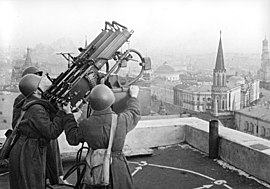
Back معركة موسكو Arabic Batalla de Moscú AST Moskva uğrunda döyüş AZ موسکو اۇغروندا دؤیوش AZB Бітва за Маскву BE Битка при Москва Bulgarian Bitka za Moskvu BS Batalla de Moscou Catalan شەڕی مۆسکۆ CKB Bitva před Moskvou Czech
| Battle of Moscow | |||||||
|---|---|---|---|---|---|---|---|
| Part of the Eastern Front of World War II | |||||||
 Soviet anti-aircraft gunners on the roof of the Hotel Moskva | |||||||
| |||||||
| Belligerents | |||||||
|
|
| ||||||
| Commanders and leaders | |||||||
| Units involved | |||||||
| Strength | |||||||
| As of 1 October 1941: | As of 1 October 1941: | ||||||
| Casualties and losses | |||||||
German strategic offensive: (1 October 1941 to 10 January 1942)
German estimated: 174,194 KIA, WIA, MIA (see §7)[14] Soviet estimated: 581,000 killed, missing, wounded and captured.[15] |
Moscow Defense:[16] (30 September 1941 to 5 December 1941)
| ||||||
The Battle of Moscow was a military campaign that consisted of two periods of strategically significant fighting on a 600 km (370 mi) sector of the Eastern Front during World War II, between October 1941 and January 1942. The Soviet defensive effort frustrated Hitler's attack on Moscow, the capital and largest city of the Soviet Union. Moscow was one of the primary military and political objectives for Axis forces in their invasion of the Soviet Union.
The German Strategic Offensive, named Operation Typhoon, called for two pincer offensives, one to the north of Moscow against the Kalinin Front by the 3rd and 4th Panzer Armies, simultaneously severing the Moscow–Leningrad railway, and another to the south of Moscow Oblast against the Western Front south of Tula, by the 2nd Panzer Army, while the 4th Army advanced directly towards Moscow from the west.
Initially, the Soviet forces conducted a strategic defence of the Moscow Oblast by constructing three defensive belts, deploying newly raised reserve armies, and bringing troops from the Siberian and Far Eastern Military Districts. As the German offensives were halted, a Soviet strategic counter-offensive and smaller-scale offensive operations forced the German armies back to the positions around the cities of Oryol, Vyazma and Vitebsk, and nearly surrounded three German armies. It was a major setback for the Germans, and the end of their belief in a swift German victory over the USSR.[17] As a result of the failed offensive, Field Marshal Walther von Brauchitsch was dismissed as supreme commander of the German Army, with Hitler replacing him in the position.
- ^ Zetterling & Frankson 2012, p. 253.
- ^ Mercatante (2012). Why Germany Nearly Won: A New History of the Second World War in Europe. Abc-Clio. p. 105. ISBN 978-0313395932.
- ^ Stahel, David (2013). Operation Typhoon: Hitler's March on Moscow, October 1941. Cambridge University Press. p. 45. ISBN 978-1107035126.
- ^ Stahel, David (2011). Kiev 1941. Cambridge University Press. p. 339. ISBN 978-1139503600.
- ^ Glantz, David M. (2001). Barbarossa: Hitler's Invasion of Russia 1941. Tempus Publishing Ltd. p. 141. ISBN 978-0739417973.
- ^ Glantz (1995), p. 78.
- ^ Liedtke 2016, p. 148.
- ^ a b Bergström 2007 p. 90.
- ^ Williamson 1983, p. 132.
- ^ Both sources use Luftwaffe records. The often quoted figures of 900–1,300 do not correspond with recorded Luftwaffe strength returns. Sources: Prien, J.; Stremmer, G.; Rodeike, P.; Bock, W. Die Jagdfliegerverbande der Deutschen Luftwaffe 1934 bis 1945, parts 6/I and II; U.S National Archives, German Orders of Battle, Statistics of Quarter Years.
- ^ a b Bergström 2007, p. 111.
- ^ Liedtke, Enduring the Whirlwind, 3449. Kindle.
- ^ "РОССИЯ И СССР В ВОЙНАХ XX ВЕКА. Глава V. ВЕЛИКАЯ ОТЕЧЕСТВЕННАЯ ВОЙНА". rus-sky.com.
- ^ "1941". Archived from the original on 25 October 2012.
- ^ "ВОЕННАЯ ЛИТЕРАТУРА --[ Исследования ]-- Мягков М.Ю. Вермахт у ворот Москвы, 1941-1942". militera.lib.ru.
- ^ a b David M. Glantz. When Titans Clashed. pp. 298, 299.
- ^ Shirer, William L. "24, Swedish (Book III)". The Rise and Fall of the Third Reich. pp. 275–87.